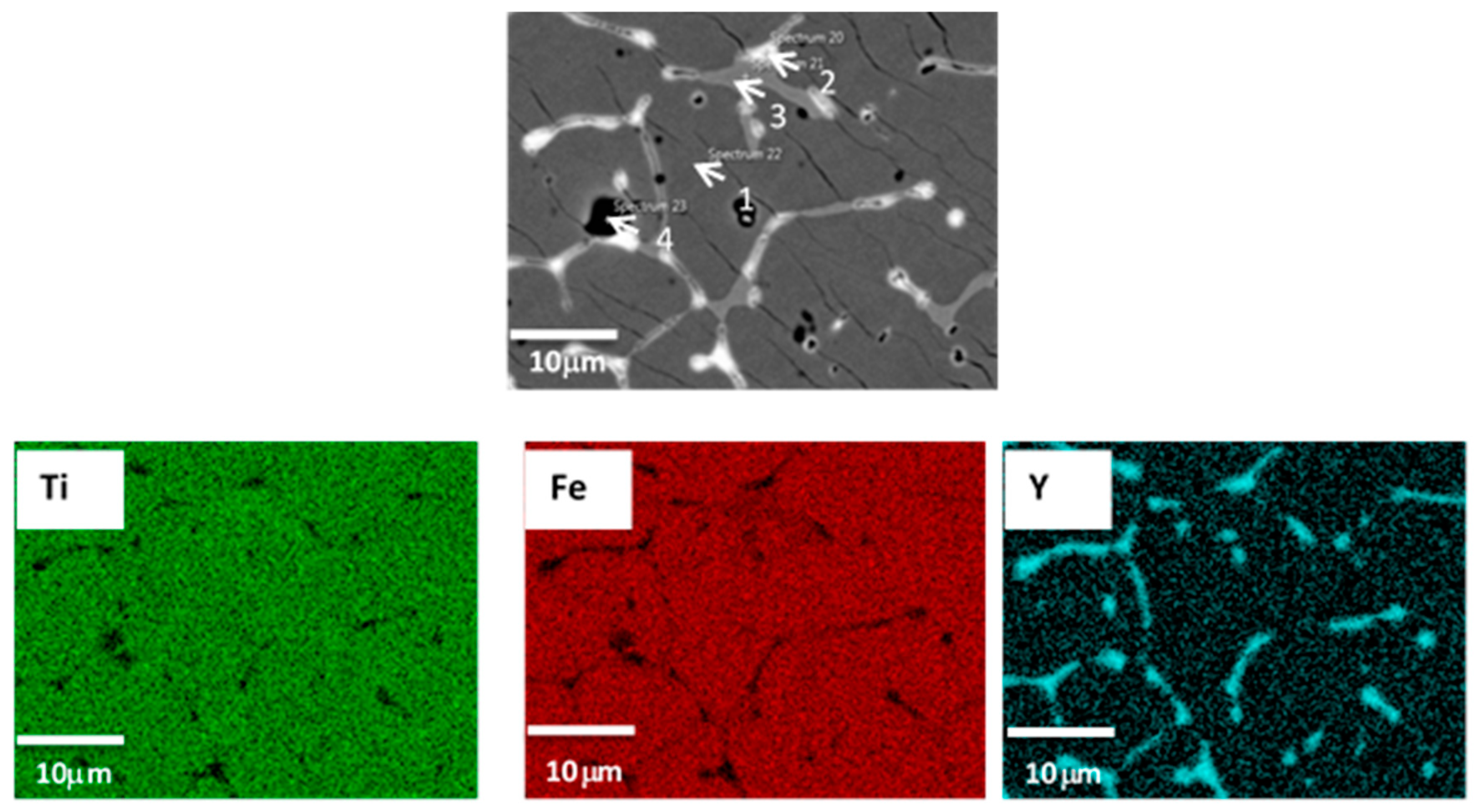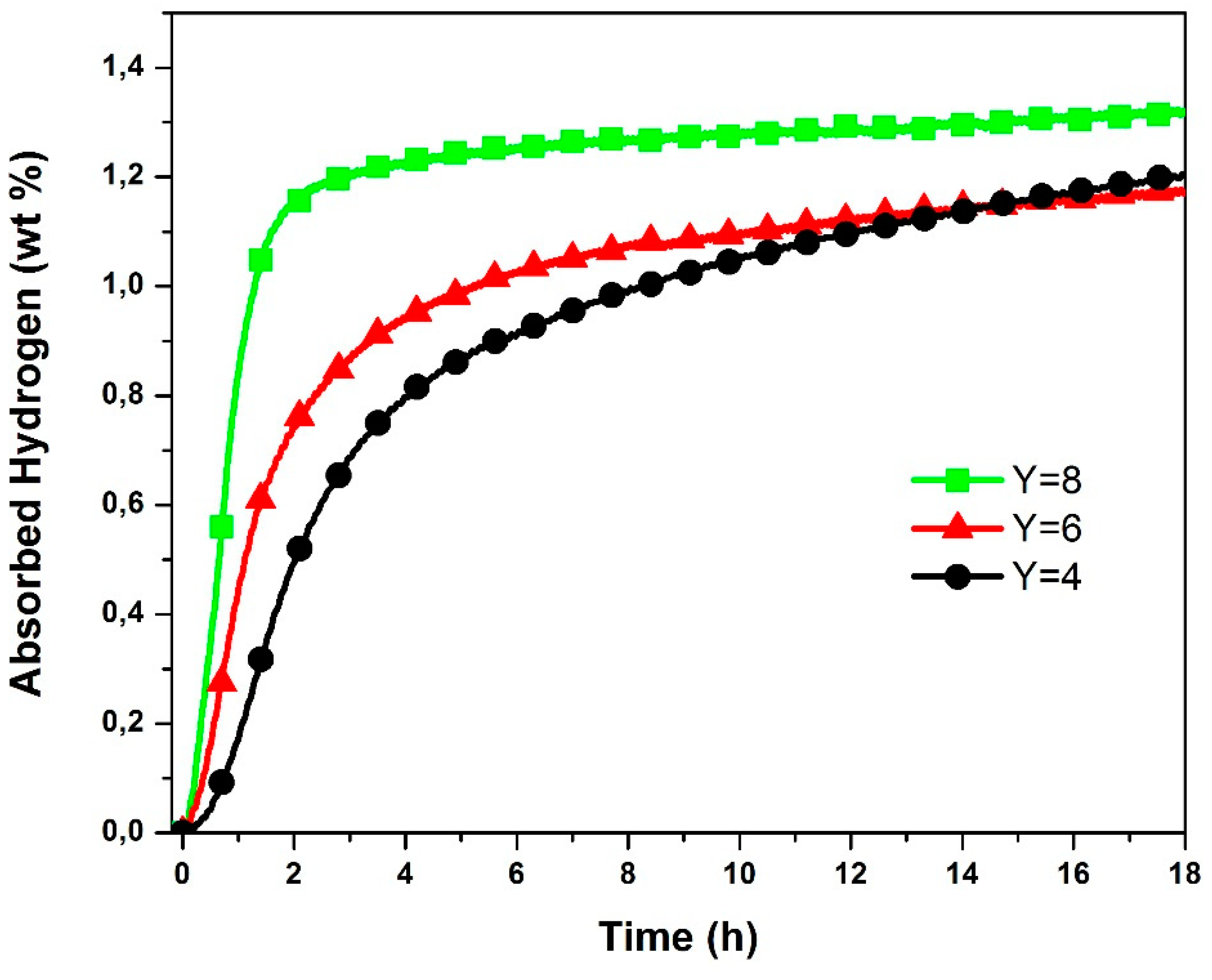First Hydrogenation Enhancement in TiFe Alloys for Hydrogen Storage Doped with Yttrium
Abstract
:1. Introduction
2. Materials and Methods
3. Results and Discussion
3.1. Microstructure
3.2. First Hydrogenation (Activation)
3.3. Crystal Structure
4. Conclusions
Author Contributions
Funding
Conflicts of Interest
References
- Reilly, J.J.; Wiswall, R.H. Formation and properties of iron titanium hydride. Inorg. Chem. 1974, 13, 218–222. [Google Scholar] [CrossRef]
- Sandrock, G.D. The metallurgy and production of rechargeable hydrides. In Hydrides for Energy Storage; Andersen, A.F., Maeland, A.J., Eds.; Pergamon: Oxford, UK, 1978; pp. 353–393. [Google Scholar]
- Hotta, H.; Abe, M.; Uchida, H. Synthesis of Ti-Fe alloys by mechanical alloying. J. Alloys Compd. 2007, 439, 221–226. [Google Scholar] [CrossRef]
- Jain, P.; Gosselin, C.; Skryabina, N.; Fruchart, D.; Huot, J. Hydrogenation properties of TiFe with Zr7Ni10 alloy as additive. J. Alloys Compd. 2015, 636, 375–380. [Google Scholar] [CrossRef]
- Gosselin, C.; Huot, J. Hydrogenation properties of TiFe doped with zirconium. Materials 2015, 8, 7864–7872. [Google Scholar] [CrossRef] [PubMed]
- Gosselin, C.; Santos, D.; Huot, J. First hydrogenation enhancement in TiFe alloys for hydrogen storage. J. Phys. D Appl. Phys. 2017, 50, 375303. [Google Scholar] [CrossRef]
- Lv, P.; Huot, J. Hydrogen storage properties of Ti0.95FeZr0.05, TiFe0.95Zr0.05 and TiFeZr0.05 alloys. Int. J. Hydrogen Energy 2016, 41, 22128–22133. [Google Scholar] [CrossRef]
- Nagai, H.; Kitagaki, K.; Shoji, K. Microstructure and hydriding characteristics of FeTi alloys containing manganese. J. Less Common Metals 1987, 134, 275–286. [Google Scholar] [CrossRef]
- Nagai, H.; Kitagaki, K.; Shoji, K.-I. Hydrogen storage characteristics of FeTi containing zirconium. Trans. Jpn. Inst. Metals 1988, 29, 494–501. [Google Scholar] [CrossRef]
- Lee, S.M.; Perng, T.P. Effect of the second phase on the initiation of hydrogenation of TiFe1−xMx (M = Cr,Mn) alloys. Int. J. Hydrogen Energy 1994, 19, 259–263. [Google Scholar] [CrossRef]
- Bershadsky, E.; Klyuch, A.; Ron, M. Hydrogen absorption and desorption kinetics of TiFe 0.8 Ni 0.2 H. Int. J. Hydrogen Energy 1995, 20, 29–33. [Google Scholar] [CrossRef]
- Nishimiya, N.; Wada, T.; Matsumoto, A.; Tsutsumi, K. Hydriding characteristics of zirconium-substituted FeTi. J. Alloys Compd. 2000, 313, 53–58. [Google Scholar] [CrossRef]
- Jain, P.; Gosselin, C.; Huot, J. Effect of Zr, Ni and Zr7Ni10 alloy on hydrogen storage characteristics of TiFe alloy. Int. J. Hydrogen Energy 2015, 40, 16921–16927. [Google Scholar] [CrossRef]
- Zadorozhnyy, V.; Klyamkin, S.; Zadorozhnyy, M.; Bermesheva, O.; Kaloshkin, S. Hydrogen storage nanocrystalline TiFe intermetallic compound: Synthesis by mechanical alloying and compacting. Int. J. Hydrogen Energy 2012, 37, 17131–17136. [Google Scholar] [CrossRef]
- Edalati, K.; Matsuda, J.; Iwaoka, H.; Toh, S.; Akiba, E.; Horita, Z. High-pressure torsion of TiFe intermetallics for activation of hydrogen storage at room temperature with heterogeneous nanostructure. Int. J. Hydrogen Energy 2013, 38, 4622–4627. [Google Scholar] [CrossRef]
- Edalati, K.; Matsuda, J.; Arita, M.; Daio, T.; Akiba, E.; Horita, Z. Mechanism of activation of TiFe intermetallics for hydrogen storage by severe plastic deformation using high-pressure torsion. Appl. Phys. Lett. 2013, 103, 143902. [Google Scholar] [CrossRef]
- Gong, W.-p.; Chang, T.-F.; Li, D.-J.; Liu, Y. Thermodynamic investigation of Fe-Ti-Y ternary system. Trans. Nonferrous Metals Soc. China 2009, 19, 199–204. [Google Scholar] [CrossRef]
- Bruker AXS. TOPAS V5: General Profile and Structure Analysis Software for Powder Diffraction Data; Bruker AXS: Karlsruhe, Germany, 2014. [Google Scholar]
- Cheary, R.W.; Coelho, A.A.; Cline, J.P. Fundamental parameters line profile fitting in laboratory diffractometers. J. Res. Natl. Inst. Stand. Technol. 2004, 109, 1–25. [Google Scholar] [CrossRef] [PubMed]
- Khajavi, S.; Rajabi, M.; Huot, J. Crystal structure of as-cast and heat-treated Ti0.5Zr0.5 (Mn1−xFex) Cr1, x = 0, 0.2, 0.4. J. Alloys Compd. 2018, 767, 432–438. [Google Scholar] [CrossRef]






| Sample | Fe | Ti | Y | |
|---|---|---|---|---|
| FeTi + 4% Y | Nominal | 49 | 49 | 2 |
| Measured | 48 | 48 | 4 | |
| FeTi + 6% Y | Nominal | 48 | 48 | 4 |
| Measured | 48 | 49 | 3 | |
| FeTi + 8% Y | Nominal | 48 | 48 | 5 |
| Measured | 47 | 50 | 3 | |
| Phase | Ti | Fe | Y |
|---|---|---|---|
| 1-Grey phase | 50 | 50 | 0 |
| 2-Bright phase | 11 | 10 | 79 |
| 3-Light grey phase | 39 | 61 | 0 |
| 4-Dark phase | 53 | 45 | 2 |
| Phase | Ti | Fe | Y |
|---|---|---|---|
| 1-Grey phase | 51 | 50 | <1 |
| 2-Dark phase | 47 | 42 | 10 |
| 3-Bright phase | 42 | 32 | 26 |
| 4-White precipitate | 3 | 2 | 94 |
| Phase | Ti | Fe | Y |
|---|---|---|---|
| 1-Grey phase | 50 | 50 | 0 |
| 2-Bright phase | 49 | 21 | 30 |
| 3-White precipitate | 2 | 1 | 97 |
| 4-Black precipitate | 99 | 1 | 0 |
| Composition | FeTi | Y | Ti-ht | BCC |
|---|---|---|---|---|
| 4 wt.% Y | 98.4(5) | 0.7(2) | 0.9(4) | - |
| 6 wt.% Y | 71(2) | 2.3(3) | 6.7(7) | 20(2) |
| 8 wt.% Y | 58(2) | 4.8(5) | 12.8(8) | 24(2) |
| Composition | Lattice Parameter a (Å) | Crystallite Size (nm) |
|---|---|---|
| 4 wt.% Y | 2.9837(3) | 36(1) |
| 6 wt.% Y | 2.9885(6) | 24(1) |
| 8 wt.% Y | 2.9854(6) | 17(1) |
© 2019 by the authors. Licensee MDPI, Basel, Switzerland. This article is an open access article distributed under the terms and conditions of the Creative Commons Attribution (CC BY) license (http://creativecommons.org/licenses/by/4.0/).
Share and Cite
Gosselin, C.; Huot, J. First Hydrogenation Enhancement in TiFe Alloys for Hydrogen Storage Doped with Yttrium. Metals 2019, 9, 242. https://doi.org/10.3390/met9020242
Gosselin C, Huot J. First Hydrogenation Enhancement in TiFe Alloys for Hydrogen Storage Doped with Yttrium. Metals. 2019; 9(2):242. https://doi.org/10.3390/met9020242
Chicago/Turabian StyleGosselin, Catherine, and Jacques Huot. 2019. "First Hydrogenation Enhancement in TiFe Alloys for Hydrogen Storage Doped with Yttrium" Metals 9, no. 2: 242. https://doi.org/10.3390/met9020242
APA StyleGosselin, C., & Huot, J. (2019). First Hydrogenation Enhancement in TiFe Alloys for Hydrogen Storage Doped with Yttrium. Metals, 9(2), 242. https://doi.org/10.3390/met9020242






